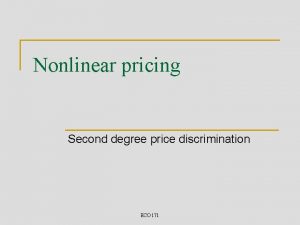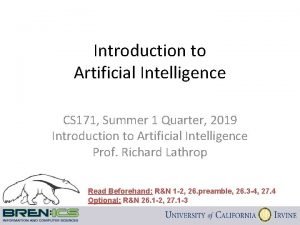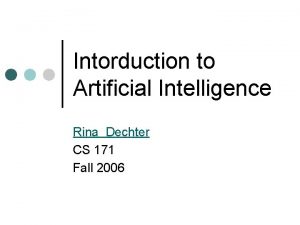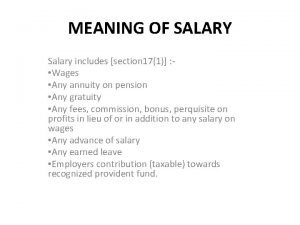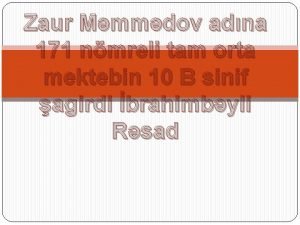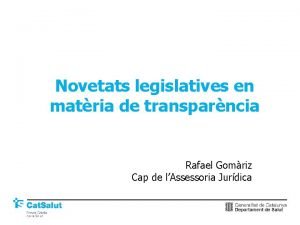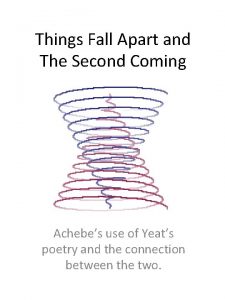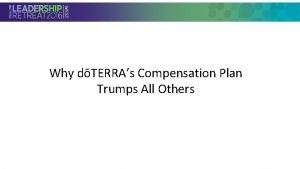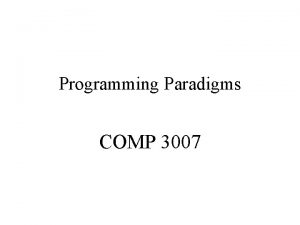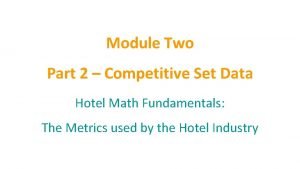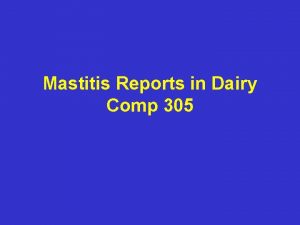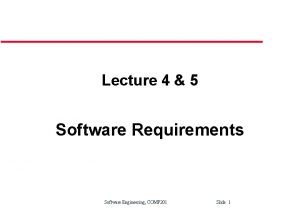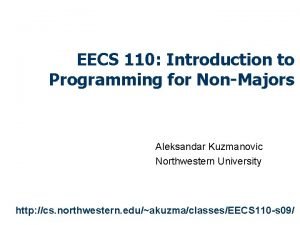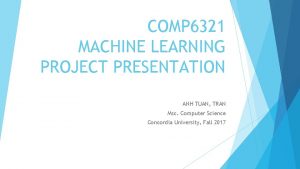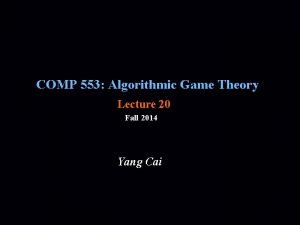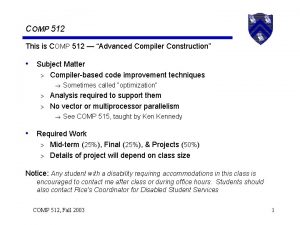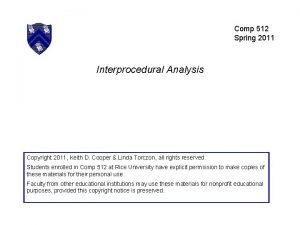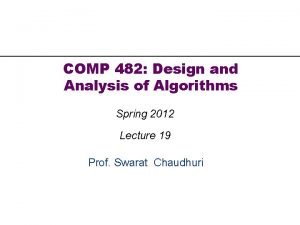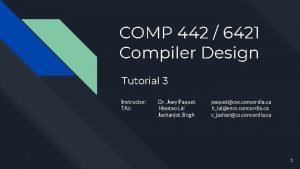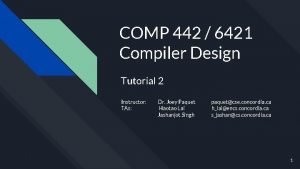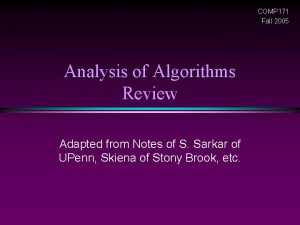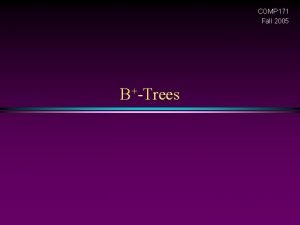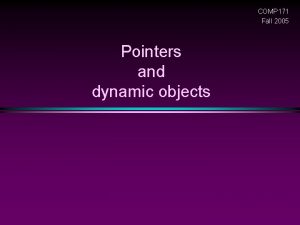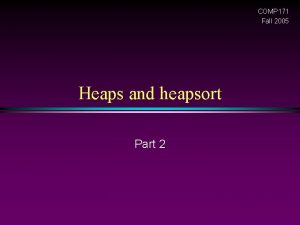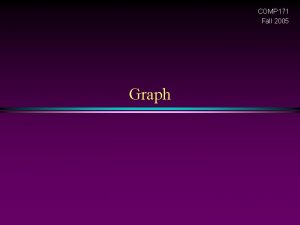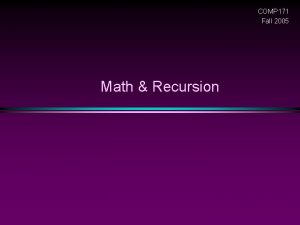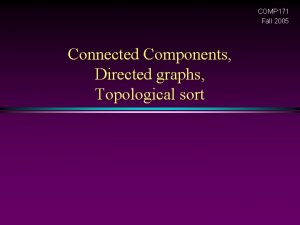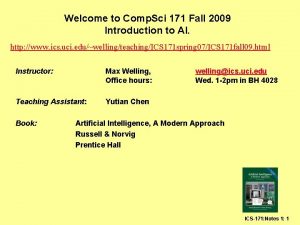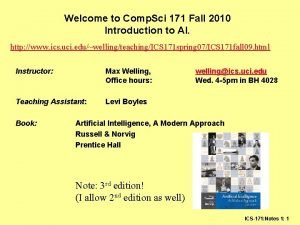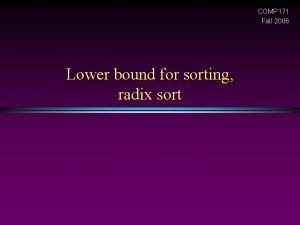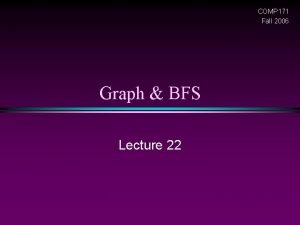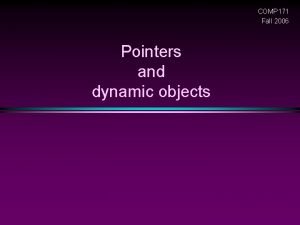COMP 171 Fall 2005 Introduction to Analysis of













































- Slides: 45

COMP 171 Fall 2005 Introduction to Analysis of Algorithms

Introduction to Analysis of Algorithms / Slide 2 Introduction * What is Algorithm? n a clearly specified set of simple instructions to be followed to solve a problem 1 Takes a set of values, as input and 1 produces a value, or set of values, as output n May be specified 1 In English 1 As a computer program 1 As a pseudo-code * Data structures n * Methods of organizing data Program = algorithms + data structures

Introduction to Analysis of Algorithms / Slide 3 Introduction * Why need algorithm analysis ? writing a working program is not good enough n The program may be inefficient! n If the program is run on a large data set, then the running time becomes an issue n

Introduction to Analysis of Algorithms / Slide 4 An Example • A city has n stops. A bus driver wishes to follow the shortest path from one stop to another. Between very two stops, if a road exists, it may take a different time from other roads. Also, roads are one-way, i. e. , the road from view point 1 to 2, is different from that from view point 2 to 1. • How to find the shortest path between any two pairs? • A Naïve approach: List all the paths between a given pair of view points Compute the travel time for each. Choose the shortest one. • How many paths are there?

Introduction to Analysis of Algorithms / Slide 5 # of paths n (n/e)n Will be impossible to run your algorithm for n = 30 Need a way to compare two algorithms

Introduction to Analysis of Algorithms / Slide 6 Example: Selection Problem * Given a list of N numbers, determine the kth largest, where k N. * Algorithm 1: (1) Read N numbers into an array (2) Sort the array in decreasing order by some simple algorithm (3) Return the element in position k

Introduction to Analysis of Algorithms / Slide 7 Example: Selection Problem… * Algorithm 2: (1) Read the first k elements into an array and sort them in decreasing order (2) Each remaining element is read one by one 1 If smaller than the kth element, then it is ignored 1 Otherwise, it is placed in its correct spot in the array, bumping one element out of the array. (3) The element in the kth position is returned as the answer.

Introduction to Analysis of Algorithms / Slide 8 Example: Selection Problem… * Which algorithm is better when N =100 and k = 100? n N =100 and k = 1? n * What happens when N = 1, 000 and k = 500, 000? * There exist better algorithms

Introduction to Analysis of Algorithms / Slide 9 Algorithm Analysis We only analyze correct algorithms * An algorithm is correct * n * If, for every input instance, it halts with the correct output Incorrect algorithms Might not halt at all on some input instances n Might halt with other than the desired answer n * Analyzing an algorithm Predicting the resources that the algorithm requires n Resources include n 1 Memory 1 Communication bandwidth 1 Computational time (usually most important)

Introduction to Analysis of Algorithms / Slide 10 Algorithm Analysis… * Factors affecting the running time computer n compiler n algorithm used n input to the algorithm n 1 The content of the input affects the running time 1 typically, the input size (number of items in the input) is the main consideration l E. g. sorting problem the number of items to be sorted l E. g. multiply two matrices together the total number of elements in the two matrices * Machine model assumed n Instructions are executed one after another, with no concurrent operations Not parallel computers

Introduction to Analysis of Algorithms / Slide 11 Worst- / average- / best-case * Worst-case running time of an algorithm The longest running time for any input of size n n An upper bound on the running time for any input guarantee that the algorithm will never take longer n Example: Sort a set of numbers in increasing order; and the data is in decreasing order n The worst case can occur fairly often n 1 E. g. in searching a database for a particular piece of information * Best-case running time n * sort a set of numbers in increasing order; and the data is already in increasing order Average-case running time n May be difficult to define what “average” means

Introduction to Analysis of Algorithms / Slide 12 Running-time of algorithms * Bounds are for the algorithms, rather than programs n programs are just implementations of an algorithm, and almost always the details of the program do not affect the bounds * Bounds are for algorithms, rather than problems n A problem can be solved with several algorithms, some are more efficient than others

Introduction to Analysis of Algorithms / Slide 13 But, how to measure the time? • Multiplication and addition: which one takes longer? • How do we measure >=, assignment, &&, ||, etc • Machine dependent? Slides courtesy of Prof. Saswati Sarkar

What is the efficiency of an algorithm? Introduction to Analysis of Algorithms / Slide 14 Run time in the computer: Machine Dependent Example: Need to multiply two positive integers a and b Subroutine 1: Multiply a and b Subroutine 2: V = a, W = b While W > 1 V V + a; W W-1 Output V

Solution: Machine Independent Analysis Introduction to Analysis of Algorithms / Slide 15 We assume that every basic operation takes constant time: Example Basic Operations: Addition, Subtraction, Multiplication, Memory Access Non-basic Operations: Sorting, Searching Efficiency of an algorithm is the number of basic operations it performs We do not distinguish between the basic operations.

Introduction to Analysis of Algorithms / Slide 16 Subroutine 1 uses ? basic operation Subroutine 2 uses ? basic operations Subroutine ? is more efficient. This measure is good for all large input sizes In fact, we will not worry about the exact values, but will look at ``broad classes’ of values, or the growth rates Let there be n inputs. If an algorithm needs n basic operations and another needs 2 n basic operations, we will consider them to be in the same efficiency category. However, we distinguish between exp(n), n, log(n)

Introduction to Analysis of Algorithms / Slide 17 Growth Rate * * * The idea is to establish a relative order among functions for large n c , n 0 > 0 such that f(N) c g(N) when N n 0 f(N) grows no faster than g(N) for “large” N

Introduction to Analysis of Algorithms / Slide 18 Asymptotic notation: Big-Oh * f(N) = O(g(N)) * There are positive constants c and n 0 such that f(N) c g(N) when N n 0 * The growth rate of f(N) is less than or equal to the growth rate of g(N) * g(N) is an upper bound on f(N)

Introduction to Analysis of Algorithms / Slide 19 Big-Oh: example * Let f(N) = 2 N 2. Then f(N) = O(N 4) n f(N) = O(N 3) n f(N) = O(N 2) (best answer, asymptotically tight) n

Introduction to Analysis of Algorithms / Slide 20 Big Oh: more examples * * * * * N 2 / 2 – 3 N = O(N 2) 1 + 4 N = O(N) 7 N 2 + 10 N + 3 = O(N 2) = O(N 3) log 10 N = log 2 N / log 2 10 = O(log 2 N) = O(log N) sin N = O(1); 10 = O(1), 1010 = O(1) log N + N = O(N) N = O(2 N), but 2 N is not O(N) 210 N is not O(2 N)

Introduction to Analysis of Algorithms / Slide 21 Some rules When considering the growth rate of a function using Big -Oh * Ignore the lower order terms and the coefficients of the highest-order term * No need to specify the base of logarithm n * Changing the base from one constant to another changes the value of the logarithm by only a constant factor If T 1(N) = O(f(N) and T 2(N) = O(g(N)), then n T 1(N) + T 2(N) = max(O(f(N)), O(g(N))), n T 1(N) * T 2(N) = O(f(N) * g(N))

Introduction to Analysis of Algorithms / Slide 22 Big-Omega * c , n 0 > 0 such that f(N) c g(N) when N n 0 * f(N) grows no slower than g(N) for “large” N

Introduction to Analysis of Algorithms / Slide 23 Big-Omega * f(N) = (g(N)) * There are positive constants c and n 0 such that f(N) c g(N) when N n 0 * The growth rate of f(N) is greater equal to the growth rate of g(N). than or

Introduction to Analysis of Algorithms / Slide 24 Big-Omega: examples * Let f(N) = 2 N 2. Then f(N) = (N) n f(N) = (N 2) (best answer) n

Introduction to Analysis of Algorithms / Slide 25 f(N) = (g(N)) * the growth rate of f(N) is the same as the growth rate of g(N)

Introduction to Analysis of Algorithms / Slide 26 Big-Theta * f(N) = (g(N)) iff f(N) = O(g(N)) and f(N) = (g(N)) * The growth rate of f(N) equals the growth rate of g(N) * Example: Let f(N)=N 2 , g(N)=2 N 2 n We write f(N) = O(g(N)) and f(N) = (g(N)), thus f(N) = (g(N)).

Introduction to Analysis of Algorithms / Slide 27 Some rules * If T(N) is a polynomial of degree k, then T(N) = (Nk). * For logarithmic functions, T(logm N) = (log N).

Introduction to Analysis of Algorithms / Slide 28 Little-oh * f(N) = o(g(N)) * f(N) = O(g(N)) and f(N) (g(N)) * The growth rate of f(N) is less rate of g(N) than the growth

Introduction to Analysis of Algorithms / Slide 29 Using L' Hopital's rule * L' Hopital's rule n If and then = * Determine the relative growth rates by using L' Hopital's rule n compute if 0: f(N) = o(g(N)) n if constant 0: f(N) = (g(N)) n if : g(N) = o(f(N)) n limit oscillates: no relation n

Introduction to Analysis of Algorithms / Slide 30 Example Functions sqrt(n) , n, 2 n, ln n, exp(n), n + sqrt(n) , n + n 2 limn sqrt(n) /n = 0, sqrt(n) is o(n) limn n/sqrt(n) = infinity, n is o(sqrt(n)) limn n /2 n = 1/2, limn 2 n /n = 2, n is (2 n), (2 n) 2 n is (n), (n)

Introduction to Analysis of Algorithms / Slide 31 Typical Growth Rates

Introduction to Analysis of Algorithms / Slide 32

Introduction to Analysis of Algorithms / Slide 33

Introduction to Analysis of Algorithms / Slide 34 Growth rates … * Doubling the input size n n n f(N) = c f(2 N) = f(N) = c f(N) = log N f(2 N) = f(N) + log 2 f(N) = N f(2 N) = 2 f(N) = N 2 f(2 N) = 4 f(N) = N 3 f(2 N) = 8 f(N) = 2 N f(2 N) = f 2(N) * Advantages of algorithm analysis To eliminate bad algorithms early n pinpoints the bottlenecks, which are worth coding carefully n

Introduction to Analysis of Algorithms / Slide 35 Example * Calculate 1 1 2 4 N 3 4 2 N+2 1 Lines 1 and 4 count for one unit each * Line 3: executed N times, each time four units * Line 2: (1 for initialization, N+1 for all the tests, N for all the increments) total 2 N + 2 * total cost: 6 N + 4 O(N) *

Introduction to Analysis of Algorithms / Slide 36 General Rules * For loops n at most the running time of the statements inside the for-loop (including tests) times the number of iterations. * Nested for loops the running time of the statement multiplied by the product of the sizes of all the for-loops. n O(N 2) n

Introduction to Analysis of Algorithms / Slide 37 General rules (cont’d) * Consecutive statements These just add n O(N) + O(N 2) = O(N 2) n * If/Else n never more than the running time of the test plus the larger of the running times of S 1 and S 2.

Introduction to Analysis of Algorithms / Slide 38 Another Example * Maximum Subsequence Sum Problem * Given (possibly negative) integers A 1, A 2, . . , An, find the maximum value of n For convenience, the maximum subsequence sum is 0 if all the integers are negative * E. g. for input – 2, 11, -4, 13, -5, -2 n Answer: 20 (A 2 through A 4)

Introduction to Analysis of Algorithms / Slide 39 Algorithm 1: Simple * Exhaustively tries all possibilities (brute force) * O(N 3)

Introduction to Analysis of Algorithms / Slide 40 Algorithm 2: Divide-and-conquer * Divide-and-conquer split the problem into two roughly equal subproblems, which are then solved recursively n patch together the two solutions of the subproblems to arrive at a solution for the whole problem n § The maximum subsequence sum can be §Entirely in the left half of the input §Entirely in the right half of the input §It crosses the middle and is in both halves

Introduction to Analysis of Algorithms / Slide 41 Algorithm 2 (cont’d) The first two cases can be solved recursively * For the last case: * find the largest sum in the first half that includes the last element in the first half n the largest sum in the second half that includes the first element in the second half n add these two sums together n

Introduction to Analysis of Algorithms / Slide 42 Example: 8 numbers in a sequence, 4 – 3 5 – 2 -1 2 6 -2 Max subsequence sum for first half =6 (“ 4, -3, 5”) second half =8 (“ 2, 6”) Max subsequence sum for first half ending at the last element is 4 (“ 4, -3, 5, -2”) Max subsequence sum for sum second half starting at the first element is 7 (“-1, 2, 6”) Max subsequence sum spanning the middle is 11? Max subsequence spans the middle “ 4, -3, 5, -2, -1, 2, 6” Slides courtesy of Prof. Saswati Sarkar

Introduction to Analysis of Algorithms / Slide 43 Algorithm 2 … O(1) T(m/2) O(m) O(1)

Introduction to Analysis of Algorithms / Slide 44 Algorithm 2 (cont’d) * Recurrence equation 2 T(N/2): two subproblems, each of size N/2 n N: for “patching” two solutions to find solution to whole problem n

Introduction to Analysis of Algorithms / Slide 45 Algorithm 2 (cont’d) * Solving the recurrence: * With k=log N (i. e. 2 k = N), we have * Thus, the running time is O(N log N) Ø faster than solution 1 for large data sets
 Pg 171
Pg 171 29052007
29052007 The verbs salir decir and venir p 155 answers
The verbs salir decir and venir p 155 answers 171
171 Ai 171
Ai 171 Ai 171
Ai 171 Meaning
Meaning 171 nomreli mekteb
171 nomreli mekteb 171 nomreli mekteb
171 nomreli mekteb Decret 171/2015
Decret 171/2015 Hazmat table
Hazmat table Cs 171 uci
Cs 171 uci 171 in binary
171 in binary 171 sayli mekteb
171 sayli mekteb 171 nomreli mekteb
171 nomreli mekteb Rti act 2005 introduction
Rti act 2005 introduction Introduction of ncf 2005
Introduction of ncf 2005 Conclusion of ncf 2005
Conclusion of ncf 2005 Microsoft sql server 2005 analysis services
Microsoft sql server 2005 analysis services Things fall apart summary chapter 4
Things fall apart summary chapter 4 Ambiguity in the fall of the house of usher
Ambiguity in the fall of the house of usher Turning and turning in the widening gyre chinua achebe
Turning and turning in the widening gyre chinua achebe President team herbalife salary
President team herbalife salary Comp tox
Comp tox Ap computer science a recursion
Ap computer science a recursion Comp 3007
Comp 3007 Hotel math fundamentals
Hotel math fundamentals Hotel comp set benchmarking
Hotel comp set benchmarking Dairy comp 305
Dairy comp 305 1991105
1991105 User requirement
User requirement Im comp plan
Im comp plan Comp 4620
Comp 4620 Excel comp planning
Excel comp planning Eecs 110
Eecs 110 Comp 410 unc
Comp 410 unc Comp sci 1102
Comp sci 1102 Comp 6321
Comp 6321 Comp 585
Comp 585 Comp 553
Comp 553 Comp 512
Comp 512 Comp 512
Comp 512 Comp 482
Comp 482 Comp 482
Comp 482 Comp 442
Comp 442 Compiler design tutorial
Compiler design tutorial



